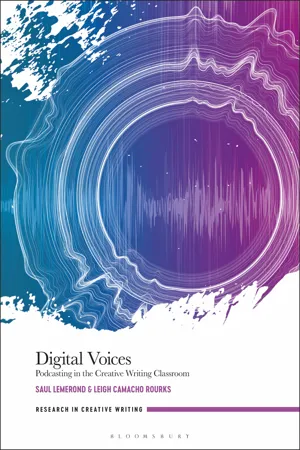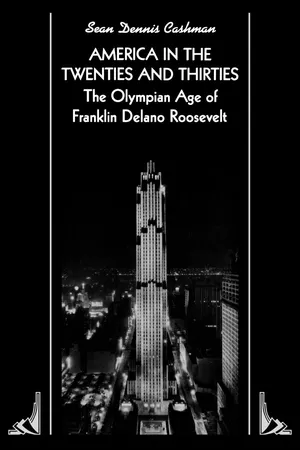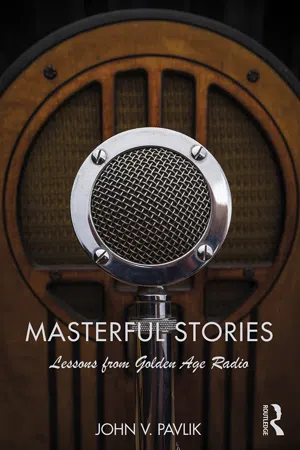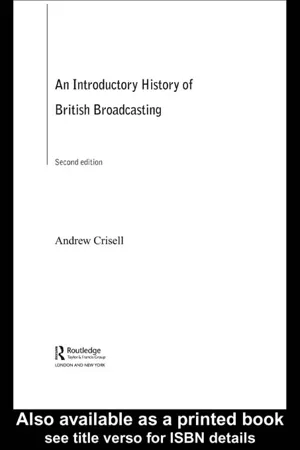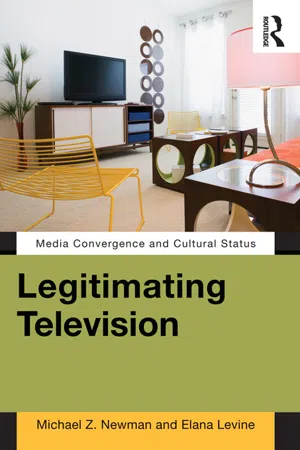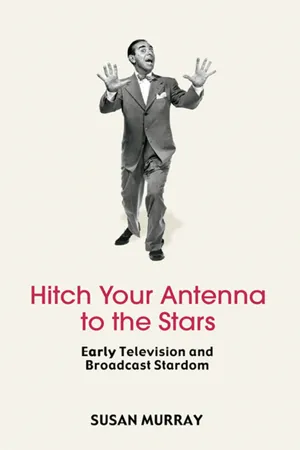History
Golden Age of Radio
The Golden Age of Radio refers to a period in the 1920s to 1950s when radio broadcasting experienced its peak popularity and influence in the United States. It was characterized by a wide variety of programming, including news, music, drama, comedy, and variety shows, which captivated and entertained audiences across the nation. This era marked a significant milestone in the development of mass media and entertainment.
Written by Perlego with AI-assistance
Related key terms
Related key terms
1 of 4
Related key terms
1 of 3
7 Key excerpts on "Golden Age of Radio"
- eBook - ePub
Digital Voices
Podcasting in the Creative Writing Classroom
- Saul Lemerond, Leigh Camacho Rourks(Authors)
- 2023(Publication Date)
- Bloomsbury Academic(Publisher)
Isolated farming communities would use them to keep up on current events in near real time. They had access to real-time fluctuating price indices of their goods. The entire country used radios to keep themselves updated on the war efforts. Radios were perhaps even more revolutionary in the realm of art and entertainment because now, for the first time, various shows could be brought into the home, a space that heretofore had been dominated by table games, music, talk, and literature, or some combination thereof. By the 1920s there were radios in a large number of American households. By 1947, 82 percent of Americans listened to radio. 10 The 1920s to 1940s came to be considered the Golden Age of Radio. And there was a mad dash among programmers to find a way to translate as many popular forms of entertainment to the medium as possible (this same phenomenon would be repeated for television in the following decades). It is during the Golden Age of Radio that we see the development of, and this list is by no means exhaustive, radio plays, situational comedies, mystery serials, soap operas, variety and talent shows, quiz shows, sports, children’s and cooking shows. This is the era of the Lone Ranger, Amos and Andy, The Shadow, Jack Benny, and Gracie Allen. Many of these shows are based off of the sorts of shows one might go to a theater, or some other form of physical venue, to see. As I alluded to earlier, all of this art and entertainment had to be selected by station programmers and then produced for a mass audience. This is significant for many reasons, but it’s significant for our discussion on podcasting as it marks a major barrier for creators that has existed for a long time. Probably the largest barrier for creators who wanted to broadcast their content was access to a transmitter. Especially if one did not have the personal ability to buy or build a transmitter - eBook - ePub
America in the Twenties and Thirties
The Olympian Age of Franklin Delano Roosevelt
- Sean Dennis Cashman(Author)
- 1989(Publication Date)
- NYU Press(Publisher)
9SOUNDS IMPOSSIBLEThe Golden Age of RadioRadio in the 1920s
AFTER THE years of experiment and innovation in 1900–1920, radio broadcasting for the general public was born in the early 1920s and almost immediately expanded, first as a novelty, and then as a major recreation of the decade. The radio boom that started in 1921 should not be seen as an inevitable part of a cultural and technological tide. Indeed, it is often more significant how such tides have failed to roll on schedule. Despite the flood, the emergence of public broadcasting was not entirely relentless. The critical steps toward the birth of American broadcasting were taken between 1918 and 1922. Despite some calls in Congress for governmental control of radio, all private communication stations were returned to their original owners on March 1, 1920, while amateur enthusiasts had been allowed back on the air in the fall of 1919. The elite of radio’s major interests believed radio would be used primarily for transoceanic and marine communiction and secondarily for long-distance telephone communications. Some wanted to mold the situation by an informal association between manufacturers and the federal government. Nevertheless, companies manufacturing radio parts believed that they must find a new market for their postwar surpluses. Almost immediately, the existing state of affairs in radio was challenged.In March 1919, when Guglielmo Marconi was negotiating to buy the rights to the Alexanderson alternator from General Electric, the Marconi Company seemed to be the only possible customer and only possible winner of exclusive rights to this new, most powerful transmitter. However, such a monopoly control over American communication was deplored by the federal government, and particularly by the navy. Under Secretary of the Navy Franklin D. Roosevelt and other members of government gave encouragement to the General Electric representative, Owen D. Young, and the company’s directors to revise the deal. General Electric would buy a controlling interest in American Marconi, anticipating and quieting any congressional objections about British Marconi having too great an influence. British Marconi agreed. As a manufacturer, General Electric was loath to run the American Marconi stations and, therefore, created the Radio Corporation of America (RCA). Eighty percent of its stock had to be American, with a government representative on the board of directors. The formation of RCA assured the United States of a new powerful position in world communication and satisfied the determination of Woodrow Wilson’s administration to challenge and supersede Britain in this new field. - eBook - ePub
Masterful Stories
Lessons from Golden Age Radio
- John V Pavlik(Author)
- 2017(Publication Date)
- Routledge(Publisher)
In radio’s Golden Age, these resources included advertising dollars that supported higher production values. At the same time, sponsors might not only fund a program but also even take responsibility for its production, with product placements often embedded throughout a show. Such sponsorship influences are still sometimes apparent in twenty-first-century digital media stories and are sometimes called “native” advertising.Toward the end of the Golden Age of Radio, audiences were shifting their attention from radio to television, especially during prime time, the evening hours, when most dramatic plays or long-format programming had aired on radio. Television was taking over the role of America’s primary source of evening home entertainment. Radio would continue to play an important role in American life, especially for those on the move, the mobile population, such as those in cars, or in the twenty-first century, those digitally and interactively connected to the Internet and communications media through their hand-held or wearable devices. In fact, as we will soon see, masterful stories continue to thrive on radio and in other audio forms in the digital age. We look toward a digital radio future that is increasingly rich in storytelling, both professionally produced and publicly engaged through social networking media.Lessons LearnedReflecting on the Golden Age of Radio, the plays examined in this book suggest important lessons for creating masterful stories, including in the twenty-first century’s digital media age. To help summarize and refine these lessons we have conducted a comparative meta-analysis of six of the masterpieces of old time radio that feature adaptations from original, previously published short stories. The findings of this meta-analysis are outlined in Table 8.1 .As Table 8.1 shows, in each case there are substantial differences between the storytelling techniques used in the original written short story and the radio play adaptation. That there are significant differences may not be surprising, but the nature and format of those shifts may be somewhat unexpected. One consistent change is each radio play makes significantly more use of dialogue to tell the story than the written version.20 Several original written stories use only about 5–7 percent of their text as dialogue, including Three Skeleton Key , Occurrence at Owl Creek Bridge , and Leiningen versus the Ants . In contrast, the radio play versions of these stories use several times as much dialogue as reflected in word count, with Three Skeleton Key using 31 percent dialogue, Occurrence at Owl Creek Bridge 38 percent dialogue, and Leiningen versus the Ants 44 percent dialogue. Even those stories that make fairly substantial use of dialogue as originally written, such as The Lottery (55 percent dialogue) and The Veldt - eBook - ePub
- Andrew Crisell(Author)
- 2005(Publication Date)
- Routledge(Publisher)
Chapter 4 The Golden Age of Radio and the rise of television
DOI: 10.4324/9780203995006-4- Listeners' harvest
- The early years of television
- The BBC's post-war television service
- The Beveridge Report and its aftermath
- The campaign for commercial television
- Sources/further reading
Listeners' harvest
Between 1945 and about 1960 BBC radio enjoyed what was probably its greatest era, broadcasting distinguished programmes of every kind, many of them regional in origin, to audiences of several million. The pioneering Radio Newsreel continued into peacetime: one of its achievements was an eyewitness report of the assassination of Mahatma Gandhi in 1947. Among special interest programmes the long-running Children's Hour was joined soon after the war by Woman's Hour on the Light Programme and, since the BBC seemed to take horticulture more seriously than it took women, by Gardeners’ Question Time on the more highbrow Home Service.From 1948 Any Questions?, which was first heard on the West Region, complemented The Brains Trust as a discussion programme which managed to be both serious and popular. Features continued to thrive, and though they might just as easily have taken a turn in the direction of documentaries or current affairs, became closely associated with radio drama, examples of which regularly won the BBC the Italia Prize for Drama between 1947 and 1955. Radio drama included adaptations of classic stage plays, but also many plays which were especially written for the medium by such established authors as Giles Cooper and Henry Reed, some of them now widely regarded as part of the literary canon. Perhaps the three most famous of these made-for-radio plays are Louis MacNeice's The Dark Tower (Home Service, 1946), Dylan Thomas's Under Milk Wood (Third Programme, 1954) and Samuel Beckett's All That Fall (Third, 1957). But much drama was not highbrow. There were hugely popular serials on the Light – crime (Dick Barton, Special Agent began in 1947) and science fiction (Journey into Space blasted off in 1953) – as well as two enduring soap operas: from 1948 Mrs Dale's Diary and, three years later, The Archers - eBook - ePub
Legitimating Television
Media Convergence and Cultural Status
- Michael Z Newman, Elana Levine(Authors)
- 2012(Publication Date)
- Routledge(Publisher)
The Golden Age designation gave early television the kind of cultural status more frequently reserved for the Broadway stage or the work of literature. Indeed, the privileging of the “artist-playwright” in critical and industrial discourse articulated the live TV dramas to these other media. In addition, while the era overall has been given the Golden Age moniker, in the 1950s, much as in the present, it was really only certain kinds of programming that were so elevated culturally. During the same years, both filmed programming and other kinds of live programming—including daytime’s serial dramas and prime time sitcoms and variety shows—also filled the broadcast airwaves. As Levine has written:In this respect, American television’s first Golden Age was as dependent on cultural hierarchies and exclusions as is the effort at legitimation in the convergence era.The high praise that distinguished primetime’s anthology dramas in the 1950s masked the fact that other kinds of television programming, programming more often derided than celebrated, were also broadcast live … Thus it was not the liveness of particular genres that earned them the distinction of being labeled art, but rather a host of gendered and classed cultural associations that allowed some liveness to be heralded while other instances were ignored or even disparaged.35While the 1950s Golden Age would end with the demise of the anthology drama, other periods in U.S. television history have also seen efforts to improve the status and reputation of the medium by emphasizing its most edifying capabilities. In the early 1960s, for example, the broadcast networks sought such an improvement in response to a climate of criticism that peaked with Minnow’s “vast wasteland” disparagement. As Michael Curtin details, Minnow and the networks focused on public affairs programming, in particular the network-produced documentary, as a corrective for the medium’s perceived failings. According to Curtin, “The documentary was characterized as the key genre for transcending the superficial and commercial aspects of the medium. Produced by network news professionals, it promised to educate and uplift the audience.”36 - eBook - ePub
Ministers of a New Medium
Broadcasting Theology in the Radio Ministries of Fulton J. Sheen and Walter A. Maier
- Kirk D. Farney(Author)
- 2022(Publication Date)
- IVP Academic(Publisher)
35The breadth of network programming during the so-called Golden Age of Radio of the 1930s and 1940s was truly remarkable. In 1958, Ohio State University’s Harrison B. Summers compiled a thirty-year history of network radio programming. He listed “all programs ten minutes in length or longer, presented on either a sponsored or on a cooperative sponsorship basis, which were parts of regular program series—as well as all of the important or moderately important sustaining programs.” Summers provided the sponsor, program information (length, day, and time), network, and ratings, when available (e.g., Hooper, Nielson). What is striking is that “to aid . . . the reader” in understanding the “general nature” and “relative proportions” of program types, Summers felt it necessary to group programs in thirty to forty-plus classifications, depending on the offerings of each radio season. Even then, the diligent professor fretted that his classifications might have a “serious shortcoming” and “errors” due to less-than-complete information on the program content of more obscure shows.36 While admitting that classifications are often inadequate, radio historian Jim Cox provides “nine genres that aired in the peak of chain radio.” Cox focuses on major entertainment shows, and provides brief descriptions of popular examples of each genre. While acknowledging their presence, he says little about categories like sports, public affairs discussions, gossip, and religion. Nonetheless, groupings and examples provide an instructive glimpse at the networks’ programming panorama: audience participation (e.g., Art Linkletter’s House Party, Truth or Consequences), personality-driven comedy (e.g., The Edgar Bergen and Charlie McCarthy Show, The Jack Benny Program), situation comedy (e.g., Baby Snooks, Fibber McGee & Molly), drama anthology (e.g., Lux Radio Theater, The Mercury Theater of the Air), juvenile adventure (e.g., The Green Hornet, Jack Armstrong—the All-American Boy), music (e.g., The Kate Smith Show, The Metropolitan Opera), mystery anthology (e.g., The Whistler, Suspense), vocational/avocational sleuths (e.g., Mr. Keen—Tracer of Lost Persons, The Shadow), and soap opera (e.g., Ma Perkins, Perry Mason).37 - eBook - ePub
Hitch Your Antenna to the Stars
Early Television and Broadcast Stardom
- Susan Murray(Author)
- 2013(Publication Date)
- Routledge(Publisher)
Obviously, television performance and its accompanying star system did not occur in a vacuum. They developed in direct relationship to radio and, to a lesser extent, to film, nightclubs, and theater. Television narratives, performance, and its production of celebrity in some ways had to make up for a perceived lack in radio, while simultaneously maintaining many of its traditions and borrowing on its successes. The industrial and economic structures that supported radio during its Golden Age carried over to television, affecting not only the manner in which stars were utilized, packaged, and sold but also what types of stars would emerge out of and flourish in this environment. For example, as we will see in succeeding chapters, vaudeo star came about logically because of the industry’s desire to differentiate itself aesthetically from other mediums, while still balancing the financial interests and needs of the networks, sponsors, advertising agencies, and audiences, most of whom were all familiar and comfortable with what they had experienced in radio. Radio set the terms for the conception of the medium of television as well as furnishing the framework for the development of broadcasting’s star system. This chapter will explore the ways that the broadcast industry prefigured the characteristics of the ideal television performer through its generation of radio talent, the interlocking economic relationships it established in its earlier years, and the particular manner in which it negotiated the coupling of entertainment and commercial narratives. In order to unearth the complex relationships that existed among radio, television, film, and stage, we need to turn to the 1920s, a period in which radio went from being a highly localized hobby for amateurs to a form of mass entertainment engaged with national narratives and shifting notions of consumerism and what it meant to be American.Indirect Advertising and Radio Talent in the 1920sDuring the decade following the end of World War I, the United States underwent massive social change. As most are aware, this was the time of prohibition, flappers, modernism, and the Jazz Age. Yet, it was also a time when the liberal values of urban life were coming into conflict with those of rural protestants; when nativists organized in response to pluralism and increasing ethnic heterogeneity; when a simultaneous suspicion of and expansion of federal power existed; and when mass production, urbanization, and popular culture were on the rise. American culture was also becoming more and more of a consumer culture as the growth of advertising and mass media industries coincided with an increase in leisure time and disposable income. According to the social historian Lynn Dumenil, both the working and middle classes “found in the consumer culture an antidote to the loss of power in the modern world, to the problem of hierarchy, routinization, and standardization.”3
Index pages curate the most relevant extracts from our library of academic textbooks. They’ve been created using an in-house natural language model (NLM), each adding context and meaning to key research topics.
Explore more topic indexes
Explore more topic indexes
1 of 6
Explore more topic indexes
1 of 4
